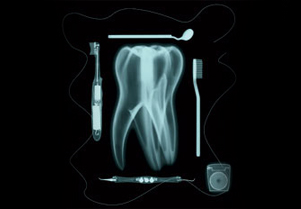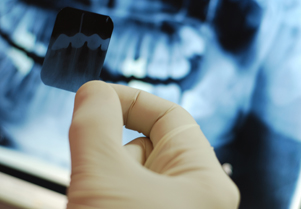SERVICII

Radiology
Description
Tipes of X- rays
Periapical viewThe periapical view is taken of both anterior and posterior teeth. The objective of this type of view is to capture the tip of the root on the film. This is often helpful in determining the cause of pain in a specific tooth, because it allows a dentist to visualize the tooth as well as the surrounding bone in their entirety.
Bitewing view
The bitewing view is taken to visualize the crowns of the posterior teeth and the height of the alveolar bone in relation to the cementoenamel junctions, which are the demarcation lines on the teeth which separate tooth crown from tooth root.
Occlusal view
The occlusal view is indicated when there is a desire to reveal the skeletal or pathologic anatomy of either the floor of the mouth or the palate.The occlusal film, which is about three to four times the size of the film used to take a periapical or bitewing, is inserted into the mouth so as to entirely separate the maxillary and mandibular teeth, and the film is exposed either from under the chin or angled down from the top of the nose. The occlusal view is not included in the standard full mouth series.
Full mouth series
A full mouth series is a complete set of intraoral X-rays taken of a patients' teeth and adjacent hard tissue.[1] This is often abbreviated as either FMS or FMX (or CMRS, meaning Complete Mouth Radiographic Series). The full mouth series is composed of 18 films:
Extraoral radiographic views
Placing the radiographic film or sensor outside the mouth, on the opposite side of the head from the X-ray source, produces an extra-oral radiographic view.
Panoramic films
A panoramic film, able to show a greater field of view, including the heads and necks of the mandibular condyles,the coronoid processes of the mandible, as well as the nasal cavity and the maxillary sinuses.
Does it involve risks?
The radiation dose the patient receives is generally less than that received during fluoroscopy and computed tomography procedures.When an individual has a medical need, the benefit of radiography far exceeds the small cancer risk associated with the procedure. Even when radiography is medically necessary, it should use the lowest possible exposure andthe minimum number of images. In most cases many of the possible risks can be reduced or eliminated with proper shielding.


